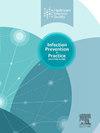Determinants of non-compliance with hand hygiene using a covert direct observation methodology
IF 1.9
Q3 INFECTIOUS DISEASES
引用次数: 0
Abstract
Background
The Hawthorne effect may result in an overestimation of hand hygiene (HH) compliance during routine observations, which may weaken the significance of factors associated with non-compliance. The aim of this study was to examine professional and healthcare determinants of HH non-compliance using covert observation.
Methods
A cross-sectional study design was conducted among healthcare workers (HCWs) at a tertiary care hospital in Saudi Arabia. HH observations were conducted discreetly by trained observers, followed by a questionnaire and an audit to identify possible determinants of HH non-compliance. HH non-compliance was assessed according to the World Health Organisation's (WHO) five-moments for HH, while inappropriate compliance was evaluated by additionally considering incorrect HH technique.
Results
A total of 6580 HH opportunities were observed by 502 HCWs. The overall non-compliance rate was 54.1% with inappropriate compliance at 71.1%. Significant factors associated (P<0.05) with non-compliance included lack of HH education/training, lack of job promotion, working in the emergency department, lack of HH auditing, absence of pocket-sized alcohol-based handrub (ABHR) bottles, inconveniently placed hand washing sinks and ABHR wall dispensers, infrequent replacement of empty ABHR wall dispensers, and lack of nearby promoting posters. With few exceptions, the determinants of HH inappropriate compliance were similar to those of HH non-compliance, when objectively audited by the researcher.
Conclusions
The findings underscore the importance of HH training and supportive healthcare infrastructures. These insights may assist decision-makers in identifying specific work environment factors that could improve HH compliance through appropriate interventions. Further research is required to evaluate the impact of these suggested modifications on HH compliance.
不遵守手卫生的决定因素使用隐蔽的直接观察方法
霍桑效应可能会导致在常规观察中对手部卫生(HH)依从性的高估,这可能会削弱与不依从性相关因素的重要性。本研究的目的是通过隐蔽观察来检查HH不遵守的专业和医疗保健决定因素。方法采用横断面研究设计,对沙特阿拉伯一家三级医院的医护人员进行调查。HH观察是由训练有素的观察员谨慎地进行的,随后是问卷调查和审计,以确定HH不合规的可能决定因素。根据世界卫生组织(WHO) HH的五个时刻来评估HH不合规,而不适当的合规则通过额外考虑不正确的HH技术来评估。结果502名HCWs共观察到6580次HH机会。总体不合规率为54.1%,不适当合规率为71.1%。与不遵守相关的显著因素(P<0.05)包括:缺乏卫生教育/培训、缺乏职位晋升、在急诊科工作、缺乏卫生审计、没有袖口大小的酒精洗手液(ABHR)瓶、不方便放置洗手槽和ABHR壁式洗手液机、不经常更换空的ABHR壁式洗手液机以及附近缺乏宣传海报。当研究者客观审计时,除了少数例外,HH不适当遵守的决定因素与HH不遵守的决定因素相似。结论研究结果强调了卫生保健培训和支持性卫生保健基础设施的重要性。这些见解可以帮助决策者识别特定的工作环境因素,这些因素可以通过适当的干预措施提高HH的依从性。需要进一步的研究来评估这些建议的修改对HH依从性的影响。
本文章由计算机程序翻译,如有差异,请以英文原文为准。
求助全文
约1分钟内获得全文
求助全文
来源期刊

Infection Prevention in Practice
Medicine-Public Health, Environmental and Occupational Health
CiteScore
4.80
自引率
0.00%
发文量
58
审稿时长
61 days
 求助内容:
求助内容: 应助结果提醒方式:
应助结果提醒方式:


